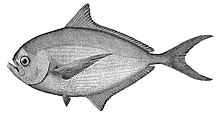
The flagtails are a family (Kuhliidae) of perciform fish of the Indo-Pacific area. The family consists of several species in one genus, Kuhlia. Most are euryhaline and often found in brackish water, but the genus also includes species restricted to marine or fresh water.
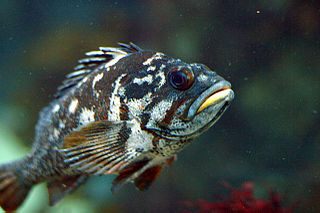
Sebastinae is a subfamily of marine fish belonging to the family Scorpaenidae in the order Scorpaeniformes. Their common names include rockfishes, rock perches, ocean perches, sea perches, thornyheads, scorpionfishes, sea ruffes and rockcods. Despite the latter name, they are not closely related to the cods in the genus Gadus, nor the rock cod, Lotella rhacina.

The Carangidae are a male to female family of ray-finned fish that includes the jacks, pompanos, jack mackerels, runners, trevallies, and scads. It is the largest of the six families included within the order Carangiformes. Some authorities classify it as the only family within that order but molecular and anatomical studies indicate that there is a close relationship between this family and the five former Perciform families which make up the Carangiformes.
Zoarces is a genus of marine ray-finned fishes belonging to the family Zoarcidae, the eelpouts. It is the only genus in the subfamily Zoarcinae. These eelpouts are found in the northern Atlantic and northern Pacific Oceans.
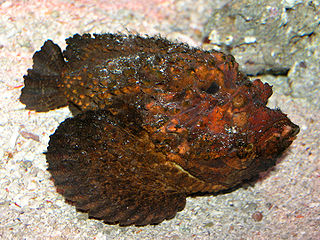
Synanceiinae is a subfamily of venomous ray-finned fishes, waspfishes, which is classified as part of the family Scorpaenidae, the scorpionfishes and their relatives. These fishes are found in the Indo-Pacific oceans. They are primarily marine, though some species are known to live in fresh or brackish waters. The various species of this family are known informally as stonefish, stinger, stingfish and ghouls. Its species are known to have the most potent neurotoxins of all the fish venoms, secreted from glands at the base of their needle-like dorsal fin spines. The vernacular name, stonefish, for some of these fishes derives from their behaviour of camouflaging as rocks. The type species of the family is the estuarine stonefish.
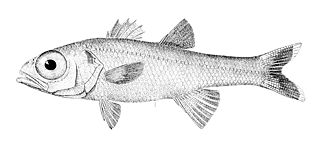
Epigonidae, the deepwater cardinalfishes, are a family of perciform fishes. The family includes about 43 species.
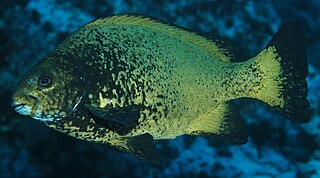
The sea chubs, also known as rudderfish and pilot fish and in Hawaiian as enenue or nenue, are a family, Kyphosidae, of fishes in the order Perciformes native to the Atlantic, Indian and Pacific Oceans usually close to shore in marine waters.
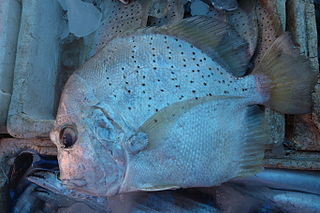
Drepane is a genus of marine and brackish water ray-finned fishes, known commonly as the sicklefishes. It is the only genus in the monotypic percomorph family Drepaneidae. These fish occur in the Indian and western Pacific Oceans, and in the eastern Atlantic near Africa.

Stichaeidae, the pricklebacks or shannies, are a family of marine ray-finned fishes in the suborder Zoarcoidei of the order Scorpaeniformes. Most species are found in the North Pacific Ocean with a few in the North Atlantic Ocean.

Bathyclupeidae is a family of Perciformes, called deep sea herrings. They are marine fishes found in tropical waters of the Atlantic Ocean, Gulf of Mexico, Indian Ocean and Pacific Ocean. They grow up to about 20 cm long.

Setarchinae, the deep-sea bristly scorpionfishes, is a small subfamily of deep-sea ray-finned fishes, it is part of the family Scorpaenidae. They are small marine fishes, growing up to 25 cm, and are found in tropical and subtropical waters throughout the world.

Albulidae is a family of fish, commonly known as the bonefishes, that are popular as game fish in Florida, select locations in the South Pacific and the Bahamas and elsewhere. The family is small, with 11 species in 3 genera. Presently, the bonefishes are in their own order: Albuliformes. The families Halosauridae and Notacanthidae were previously classified in this order, but are now, according to FishBase, given their own order Notacanthiformes. The largest bonefish caught in the Western Hemisphere is a 16-pound, 3 ounce example caught off Islamorada, Florida, on March 19, 2007.

The bluespine unicornfish, also known as the short-nose unicornfish, is a species of marine ray-finned fish belonging to the family Acanthuridae, the surgeonfishes, unicornfishes and tangs. This species is found in the Indo-Pacific. It is occasionally found in the aquarium trade. It grows to a size of 70 cm in length. It is called kala ('thorn') in Hawaii, dawa in New Caledonia, and ta or tā in Fiji.

The oceanic basslets are ray-finned fish that belong to the small family Howellidae within the superfamily Percoidea of the suborder Percoidei part of the order Perciformes. The family includes about 9 species. They are mostly deep-water species, some of which move to shallower waters at night. Various species are found in the Indian Ocean, Pacific Ocean, including the Coral Sea, and Atlantic Ocean, including the Caribbean Sea.

Hemilepidotus, the Irish lords, is a genus of ray-finned fishes belonging to the family Agonidae, the poachers and sea ravens. These fishes are found in northern Pacific, northern Atlantic and the Arctic Oceans.
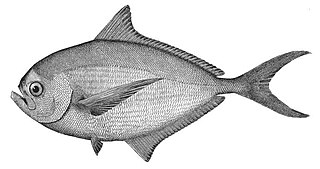
Brama is a genus of marine ray-finned fishes from the family Bramidae, the pomfrets. Currently, there are 8 species within the genus.

Pterycombus is a genus of pomfret distinguished by greatly elongated dorsal and anal fins. Along with the genus Pteraclis, these fishes are commonly referred to as fanfishes. Pterycombus can be distinguished from Pteraclis by examining the dorsal and anal fin rays, which should be relatively uniform in thickness to neighboring rays and by a lack of scales anterior to the dorsal fin.
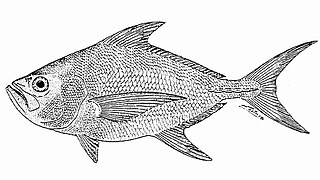
Taractes is a genus of marine ray-finned fishes from the family Bramidae, the pomfrets. Taractes can be distinguished from other bramid genera but having a flat, or slightly curved profile, between the eyes and by having scales on both the dorsal and anal fins.

Kyphosus is a genus of sea chubs native to the Atlantic, Indian and Pacific oceans. It is the only genus in the subfamily Kyphosinae of the family Kyphosidae.
Xiphisterinae is a subfamily of marine ray-finned fishes, classified within the family Stichaeidae, the pricklebacks or shannies. These fishes are found in the North Pacific Ocean.
